Dichroic Filters
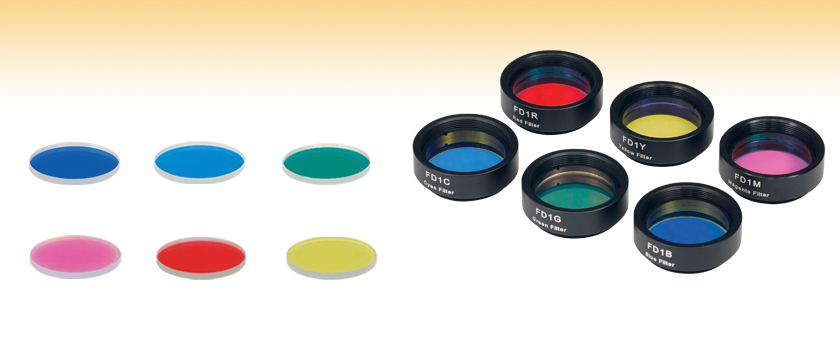
- Will Not Fade Like Gels or Plastic Filters
- Multilayer Thin Film Coating on Glass Substrates
- Mounted Filters Available in Kit
FD1M
Ø1" Magenta Filter
FD1Y
Ø1" Yellow Filter
FD1C
Ø1" Cyan Filter
FD1D
SM1-Mounted Dichroic Filter Set, 6 Pieces
FD1B
Ø1" Blue Filter
FD1G
Ø1" Green Filter
FD1R
Ø1" Red Filter

Please Wait
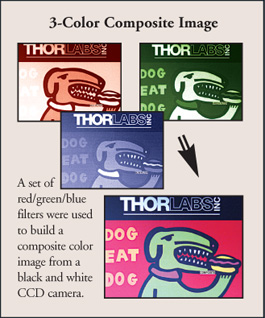
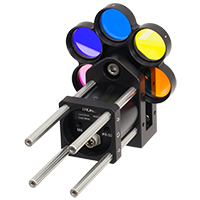
Click to Enlarge
Dichroic filters can be used with a white LED array to selectively illuminate a sample with a particular color.
Features
- Multilayer Thin Film Coating on Glass Substrates
- Will Not Fade Like Gels or Plastic Filters
- Ø1" Unmounted Filters Sold Individually
- Mounted Filters Available in a Kit
Thorlabs offers high-quality Additive and Subtractive Dichroic Filters with a strong emphasis on durability. Unlike plastic filters or gels, these coatings will not fade with time and can handle much higher temperatures. Our dichroic color filters can be mounted in our Ø1" lens tubes or filter mounts.
Additive and subtractive dichroic filters are used to separate color in CCD imaging, digital projection, machine vision, and printing. These filters allow only a portion of the visible spectrum to pass and reject (reflect) the rest.
In the simplest case, using the red, green, and blue additive filters in succession with a black and white CCD camera, a high-contrast color image may be achieved. Unlike the traditional color CCD, which uses groups of three spatially separated pixels to achieve this effect, using filters maintains the resolution of the camera. In digital projection, additive filters are used to enhance contrast. In machine vision, a single filter can be placed before the CCD camera to increase contrast, which makes sorting items much simpler. Often, copy machines and print preprocessing centers use subtractive filters to make the images that will later be printed in ink.
| General Specifications | |
|---|---|
| Angle of Incidence | 0° |
| Material | Borofloat Glass |
| Surface Quality (Scratch-Dig) | 80-50 |
| Clear Aperture | Ø22.9 mm |
| Temperature Range | -50 to +80 oC |
| Diameter | Ø25.4 mm +0/-0.25 mm |
| Thickness | 2 mm +0.2/-0.5 mm |
| Individual Filter Specifications | |
|---|---|
| Additive Filters | Subtractive Filters |
| FD1B Transmission: >85% avg. for 390-480 nm <1% avg. for 540-750 nm Cut-off: 505 ± 15 nm |
FD1C Transmission: >85% avg. for 390-530 nm <1% avg. for 585-710 nm Cut-off: 555 ± 15 nm |
| FD1G Transmission: >70% @ peak <1% avg. for 400-460 nm Low Edge: 505 ± 15 nm High Edge: 575 ± 15 nm |
FD1M Transmission: >75% avg. for 395-440 nm and 645-750 nm <1% avg. for 500-590 nm |
| FD1R Transmission: >75% avg. for 615-730 nm <1% avg. for 380-550 nm Cut-on: 585 ± 15 nm |
FD1Y Transmission: >85% avg. for 550-750 nm <1% avg. for 410-475 nm Cut-on: 515 ± 15 nm |
Below are plots showing the percent transmission versus wavelength of our dichroic filters for four different angles of incidence (AOI). Please note that for clarity reasons we have only plotted data for four different AOIs. Raw data in 5° increments (i.e., at 0°, 5°, 10°, 15°, 20°, 25°, 30°, 35°, 40°, and 45°) can be obtained by clicking on the link below each graph.
| Posted Comments: | |
jon morris
(posted 2022-07-01 15:16:55.31) which if any of these "mounted dichroic glass filters" will fit an ARRI field kit 650 Watt tungsten light housing in the existing scrim retaining slot. (to convert the tungsten 3200K to daylight 5500K output) I do not have access to the light right now, but my guess is that the scrims I have are approx. 6- 8" diameter.
If you sell this item, what is you product # and current price with shipping to San Francisco, California? cdolbashian
(posted 2022-07-19 02:57:09.0) Thank you for contacting Thorlabs. We can do special design for this kind of unmounted filters, we will reach out to you directly to gather more detailed information about your application so that we can evaluate the feasibility of the customization. For future custom requests please feel free to contact our Solutions Team (techsales@thorlabs.com). Doyk Hwang
(posted 2019-12-05 11:06:16.65) Hi there,
Can we place a customized order for the thinner FD1M mirrors, like 0.5 mm thickness or less?
Best,
Doyk nbayconich
(posted 2019-12-11 02:27:03.0) Thank you for contacting Thorlabs. We can offer FD1M with 0.5 mm thickness. A Techsupport representative will reach out to you directly with more information. Brian Mittelstaedt
(posted 2019-09-26 11:48:17.103) When using the FD1G in front of a sensor, is there a preferred orientation? Is the spectral transmission the same regardless of which side faces the sensor? YLohia
(posted 2019-09-30 09:56:11.0) Hello, thank you for contacting Thorlabs. The spectral transmission will be the same regardless of orientation. That said, the best practice is to orient the coated side towards the incoming beam. Coated side can be differentiated by eye by tilting the part. jing li
(posted 2019-03-16 04:50:11.64) Hi,
I bought FD1B filter which used to make a optical device, now I need do some analog computation of the device, could you tell me the thickness and refractive index of the film deposited on the mirror? Thank you! nbayconich
(posted 2019-03-19 09:01:43.0) Thank you for contacting Thorlabs. Unfortuntaely we cannot share specific index values or the thickness of our coating layers for these filters. alexis.wartelle
(posted 2019-01-22 10:10:10.24) Hello,
I would like to know how these filters behave with respect to polarization, in particular with non-zero incidence angle. Does the transmission behaviour change for polarized light, depending on the polarization direction?
Besides, the magenta and green filters would be valuable to me for a setup in which green light must be separated from blue and red light. I would like to know if the reflection from the filters behaves just like one expects from the transmission curves or if there are caveats. E.g: for incoming light with red, blue and green, if the magenta filter is set in at 45°, can one hope to get all the green light deflected by 90°?
Best regards llamb
(posted 2019-01-25 01:32:03.0) Thank you for your feedback. When the Angle of Incidence is 0°, the transmission will be the same regardless of polarization. At non-zero AOIs, the transmission will depend on the input polarization states, though we do not currently have test data regarding this. Additionally, the beam will indeed reflect when outside of the standard transmission band, which should be usable in applications similar to yours. I will reach out to you directly to discuss your application further. mss2257
(posted 2018-05-03 15:12:47.343) Hi, I was wondering if more details could be obtained about the engineering of the dichroic filter? I plan on using this as a substrate in a reflectance experiment, and I would like to know the thicknesses of the optical materials deposited, and their refractive indeces, for calculation purposes. YLohia
(posted 2018-05-08 08:40:52.0) Hello, thank you for contacting Thorlabs. Unfortunately, we cannot share the thickness of coatings or their indices of refraction since that information is proprietary. user
(posted 2015-04-07 05:56:40.03) Is it possible to obtain transmission data above 800nm at AOI = 0° for the red, green and blue dichroic filters ? jlow
(posted 2015-04-14 09:43:01.0) Response from Jeremy at Thorlabs: We can provide more information about this. Since you did not leave your contact info, can you contact us at techsupport@thorlabs.com about this please? Greg
(posted 2009-02-05 08:22:43.0) A response from Greg at Thorlabs to acable: Our dichroic filter sets do not currently include a storage box. acable
(posted 2008-12-15 16:11:58.0) Does the kit come with a storage box to organize the optics. Laurie
(posted 2008-10-01 16:16:10.0) Response from Laurie at Thorlabs to cpontbriand: We have just added information to our website (see the Graphs Tab) showing transmission vs. wavelength for our dichroic filters at various incident angles. I apologize that it took so long to add this information, but our coating department needed to collect this data as the information was not on file. If you have any additional questions, please feel free to contact us. cpontbriand
(posted 2008-09-02 11:48:51.0) To Whom it may concern,
I see that your dichroic filters have applications in imaging and illumination, but the stated angle of incidence is 0 degrees. There must be some tolerance about 0 degrees, given the stated applications. What sort of useable angle of incidence should I expect to get from these filters?
Thank you,
Clifford Pontbriand
Engineer
Woods Hole Oceanographic Institution |

The FD1D Dichroic Filter Set includes one of each of our red, green, and blue additive filters as well as one of each of our cyan, magenta, and yellow subtractive filters, each housed in an SM1-threaded (1.035"-40) housing that is engraved with the item number.
| Item # | Included Filters |
|---|---|
| FD1D | FD1B, FD1G, FD1R, FD1C, FD1M, and FD1Y |
 Products Home
Products Home









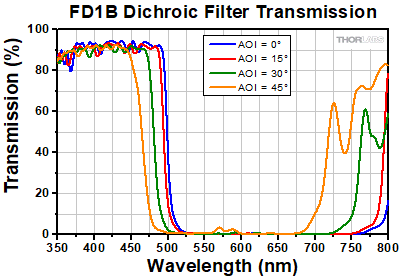
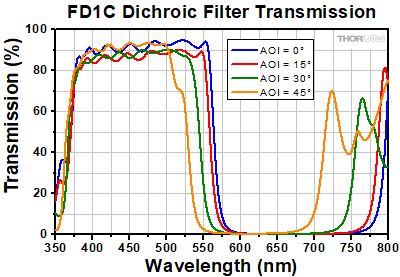
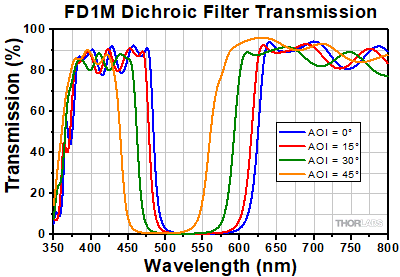
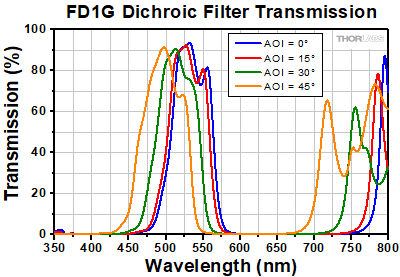
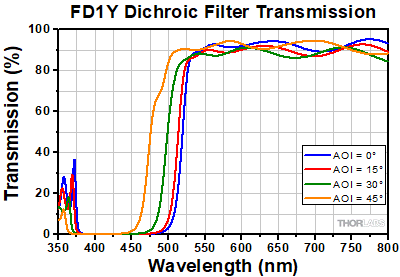


 Zoom
Zoom Dichroic Color Filters / Kit
Dichroic Color Filters / Kit